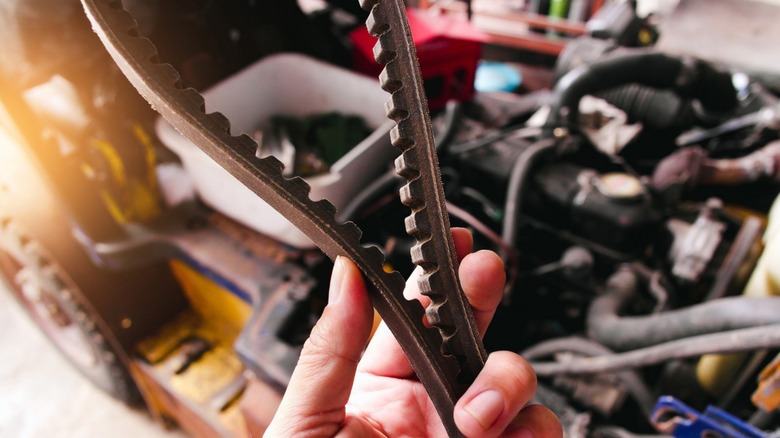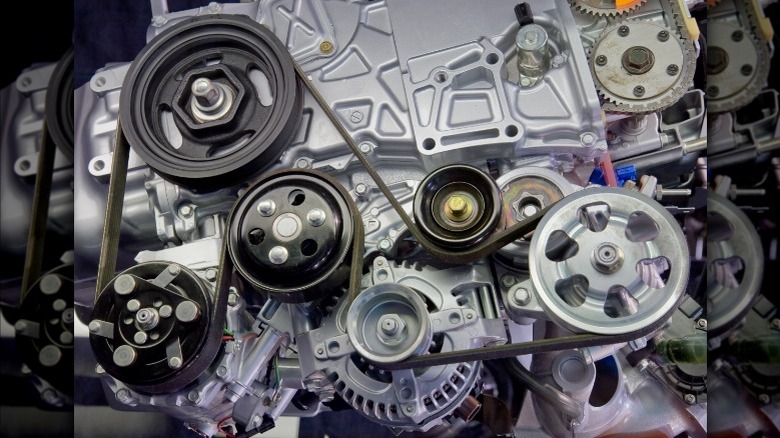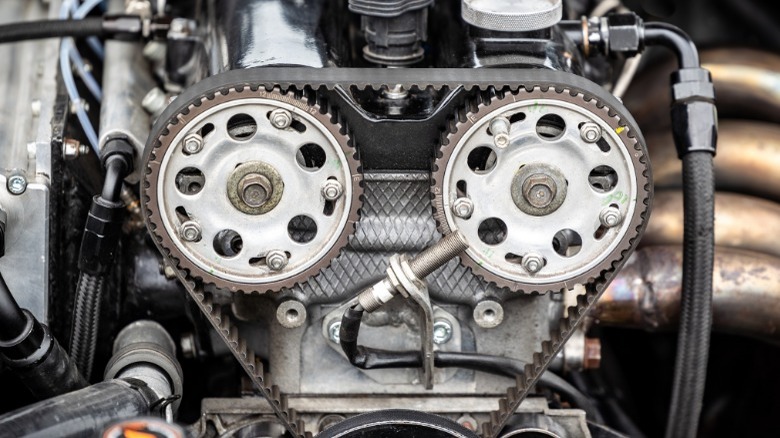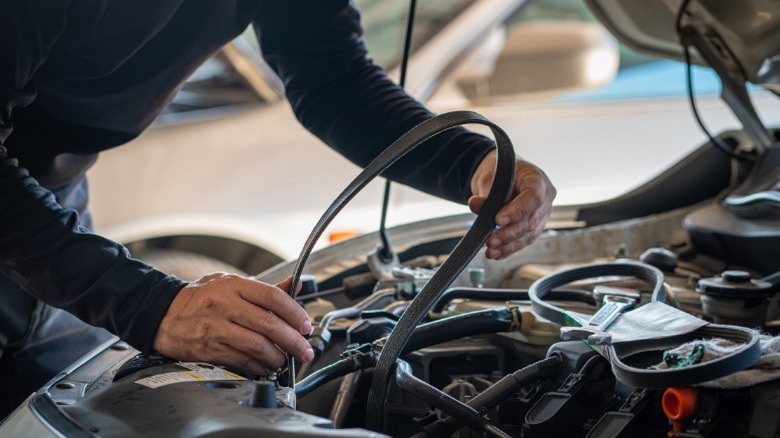Serpentine Belt Vs. Timing Belt: Are They The Same Thing?
Your car's internal combustion engine requires a massive amount of individual parts to make it run. From the tiniest nuts and bolts to hulking crankshafts and engine blocks, modern motors are composed of a huge number of parts, each with a key role to play in the process of sending your vehicle down the road. Some of the more recognizable components found on automotive engines are belts, which come in various shapes and sizes and serve distinct purposes. Specifically, you may have heard of the timing belt and the serpentine belt. You may have even paid to have one or both of them replaced at some point. But what exactly do these two belts do, and is there a difference between them?
The fact is that serpentine belts and timing belts are not the same thing. While both belts are vital components for your car's engine, they serve unique purposes and are not interchangeable. In most vehicles, the timing belt is housed toward the front of the engine, usually beneath a shield known as the timing belt cover. Its job is to connect the crankshaft to the camshaft and synchronize their spinning so that the engine's valves open at the proper times. The serpentine belt, on the other hand, is usually found on the front of the engine, exposed to the front or side of the engine bay. It is not protected by a cover and looks like a simple rubber belt snaking around a series of pulleys.
If you're interested in learning more about these two belts, how they work, and why they're important, you're in luck. We'll break it all down for you in simple terms. So, let's dive in and explore the differences between serpentine belts and timing belts.
What is a serpentine belt?
The serpentine belt or drive belt is a vital engine component responsible for providing power to various engine accessories, like the alternator, air conditioning compressor, and power steering pump. It's built of heavy-duty rubber and wraps around various engine pulleys, causing them to spin and send power to the associated accessory systems. The belt is able to do this thanks to its connection to the crankshaft. Let's explain.
Your internal combustion engine gets its power from small, contained explosions. Those explosions cause the pistons to move up and down inside the motor, which, in turn, causes the crankshaft to spin. While one end of the crankshaft connects to the transmission, the other end connects to an external pulley on the front or side of the engine. As the crankshaft rotates, its pulley spins. The serpentine belt wraps around that pulley and transfers its energy to various other pulleys, providing rotational power to accessories like the AC compressor and power steering pump.
Serpentine belts are extremely durable, but they don't last forever, so you'll need to change yours periodically. Replacement intervals will vary based on your car's make and model and its age. However, most manufacturers recommend changing the serpentine belt every 60,000 to 100,000 miles. It's also worth noting that your serpentine belt may fail before it's time for a replacement. There are several signs that your engine's serpentine belt needs to be replaced, and it's a good idea to familiarize yourself with the symptoms to avoid breakdowns and other mechanical issues.
What is a timing belt?
The timing belt is a key component that ties multiple engine systems together and allows them to function harmoniously. We've mentioned that tiny explosions inside the motor propel pistons up and down, which causes the crankshaft to spin and transfer power to various other parts of the car, including the serpentine belt. The crankshaft also connects to the timing belt, a thick rubber strap with deep grooves that synchronizes the movement of the camshaft(s) with the pistons.
The movement of the camshaft and the pistons must be timed perfectly because the camshaft — or camshafts for DOHC engines — controls the opening and closing of the intake and exhaust valves. Remember those small, contained explosions that power the entire engine? If the valves don't open and close at the proper time, the right amounts of fuel and oxygen may not enter the combustion chambers, resulting in explosions that are too big, too small, or that come at the wrong time.
It's somewhat complex, but basically, the timing belt is the glue that holds the entire combustion process together, a feat it achieves thanks to its precise tension. Timing belts must be set to the proper tension in order to ensure that the camshaft remains synchronized with the crankshaft. Because of that, timing belts require maintenance. While many modern vehicles use timing chains, which can last for much longer periods of time, many older vehicles still have timing belts. These belts wear out over time, and you have to replace them if you want to avoid severe engine problems. The replacement intervals vary based on your vehicle, but most automakers recommend replacing the timing belt every 70,000 to 90,000 miles.
Can you DIY a serpentine or timing belt replacement?
While serpentine and timing belts are both extremely durable, they don't last forever. When the time comes, you'll have to replace them. The serpentine belt is fairly easy and cheap to replace. If you pay a professional mechanic to do it for you, you'll most likely be looking at a bill between $100 and $150, depending on your vehicle and where you live. However, if you don't feel like paying for the service, you can do it yourself. In fact, serpentine or drive belt replacement is one of the best DIY engine maintenance tasks you can do at home. It requires only basic tools and rudimentary car knowledge, and even novices should be able to tackle the job with the right know-how.
Timing belt replacement, on the other hand, is neither cheap nor easy. If you visit a professional technician for the service, you'll likely pay between $600 and $800 or more, depending on your car and the labor rates in your area. That's because replacing the timing belt is a highly technical, labor-intensive process that must be performed by an expert. Not only does replacing the timing belt involve disassembling large portions of the engine and surrounding components, it also involves replacing the water pump on many vehicles and installing the new timing belt with perfect precision to avoid engine problems. Experienced home mechanics can tackle a timing belt replacement themselves, provided they have the proper tools, but car novices and casual DIYers are probably better off hiring a professional.



